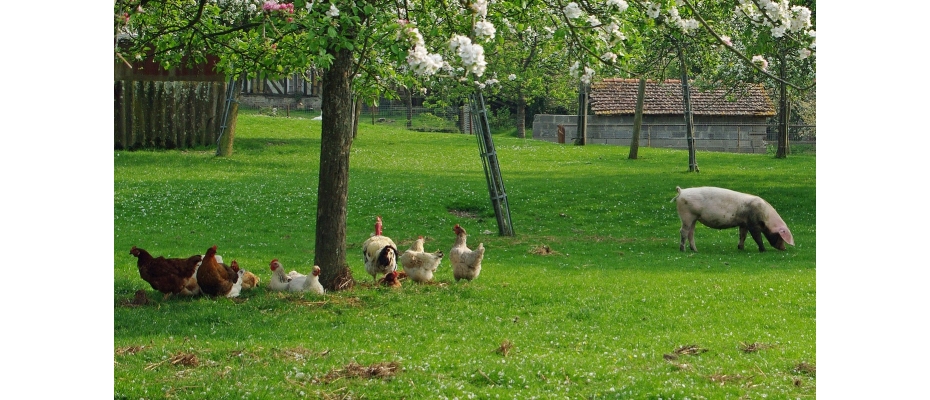
BCN, 18 June 2021.- In the new European research project 3D’omics, researchers aim to address major challenges in animal production by creating and optimising a technology to analyse animal-microbiota interactions at the microscale. The developed technology will be implemented in two production systems, namely poultry and swine. The project involves both university and industry partners and has received €10 million over the next four years from EU Horizon 2020.
Billions of farm animals provide food to humans worldwide. However, large-scale animal production also faces major challenges: Production of considerable amounts of waste, usage of antibiotics and harvest of enormous amounts of crops.
3D’omics, a new European project supported by EU Horizon 2020, aims to minimize the impact of those challenges by understanding the interactions between animals and microorganisms. The project is led by the University of Copenhagen, and the consortium includes scientists from eight European universities and research institutions, as well as five different companies from the private sector. The Structural Genomics group at the Centro Nacional de Análisis Genómico and the Centre for Genomic Regulation led by Marc A. Marti-Renom is one of the partners of 3D’omics.
Project coordinator at the University of Copenhagen Antton Alberdi explains that identifying microbial communities that interact optimally with animals can contribute to preventing development of diseases by boosting immunity of animals, using less medical drugs, improving digestive capacity of organisms, and thus producing less waste.
“Gut microorganisms have a systemic impact on many biological processes of farm animals. Because of this, understanding animal-microbiota interactions is recognised as one of the key steps to advance towards more efficient animal production, more sustainable procedures and to improve the welfare of animals,” says Antton Alberdi, Assistant Professor at the Center for Evolutionary Hologenomics, GLOBE Institute.
Discovering the host-microbe interactions in a 3D environment
The project aims to develop a brand new technology, which functions as a framework to analyse the data at the microscale. The resulting technology will allow researchers “to see”, in 3D, the interactions between microbes and other microbes as well as with the host, hence the project’s name, 3D’omics.
And scientists are in need of a new methodology to progress in the understanding of the intricate interactions on micro scale, explains Antton Alberdi.
“An analogy of the current procedures used for analysing intestinal microbial communities would be to collect trees and birds in the Amazon rainforest, mix them all in a giant blender, extract DNA from the mixture to reconstruct their genomes, and finally try to determine which bird nests on which tree. Clearly, the approach can be improved,” he says.
By generating high-quality imaging and molecular data, the scientists will be able to reconstruct the interactions among bacteria as well as between bacteria and animal hosts while accounting for their three-dimensional spatial features.
The technology will combine different types of biological data, including fluorescence imaging, bacterial genome sequencing, gene expression data and metabolomics, to reconstruct the biomolecular interactions of bacteria and animal intestinal cells in three dimensions.
“Our lab will be responsible of integrating the multi-omics data obtained by our partners to build 3D models of the animal-microbiota interactions. We hope that 3D’omics will benefit from our broad expertise on the development and application of computational methods for predicting the 3D structures of macromolecules and their complexes”, says Marc A. Marti-Renom, group leader at CNAG-CRG and CRG and ICREA research professor.
“3D’omics is structured in three stages,” explains Antton Alberdi.
“In the first stage, the consortium will develop and optimise the 3D’omics technology, from the field to data analysis, through the interdisciplinary collaboration of multiple partners with very different expertises,” he says.
In the second stage, the developed technology will be implemented in two production systems, namely poultry and swine, aiming at addressing specific production challenges. In poultry, for example, the goal is to understand the specific mechanisms of action of a feed additive in chickens.
“We will also study the interactions between a deadly pathogenicity of turkeys and the gut microbiota that it requires to develop its pathogenity. In swine, we will study how fibres engineered for boosting the growth of specific microorganisms modify microbial aggregations, and how this affects digestibility of nutrients,” Antton Alberdi explains.
In the third stage, the impact of the 3D’omics technology and its implementability in current industrial set-ups will be assessed.
The methodological framework will be made applicable to a variety of scientific disciplines including animal and life sciences, as well as basic ecology and evolution.
The project 3D’omics
The project is a part of the Horizon 2020 Research and Innovation Action and involves 11 European countries. 3D’omics receives €10 million over the next four years with the University of Copenhagen (UCPH) as the coordinating institution. The following institutions are involved:
Universities:
- University of Copenhagen (Denmark)
- University of Veterinary Medicine (Austria)
- KU Leuven (Belgium)
- ETH Zurich (Switzerland)
- Ben Gurion University (Israel)
- Norwegian University of Life Sciences (Norway)
Research Institutes:
- Centro Nacional de Análisis Genómico (Spain)
- Centre for Genomic Regulation (Spain)
- Max Delbrück Center for Molecular Medicine (Germany)
Companies:
- Aviagen, poultry breeding (United Kingdom)
- Norsvin, swine breeding (Norway)
- Biomin, feed additives (Austria)
- Novogene, sequencing services (The Netherlands)
- Afekta, metabolomics services (Finland)











